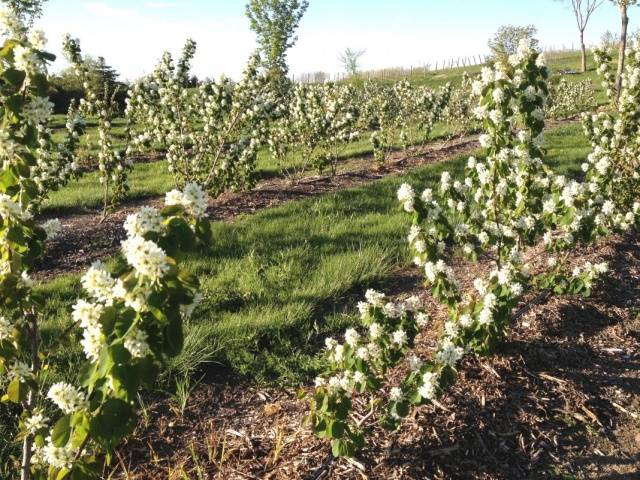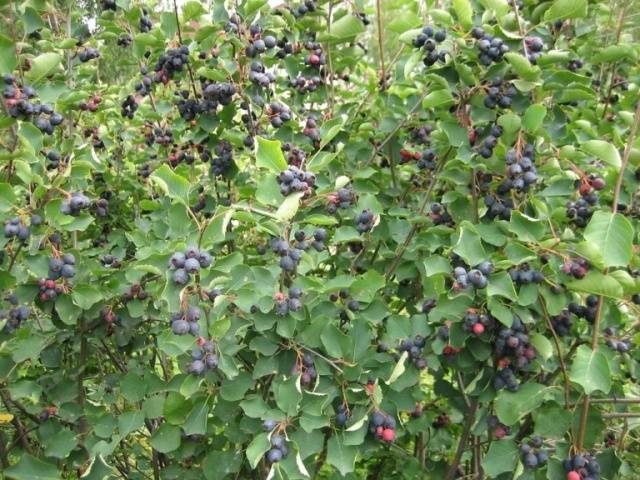Content
One of the first descriptions of Irgi round-leaved was made by the German botanist Jacob Sturm in his book "Deutschlands Flora in Abbildungen" in 1796. In the wild, this plant of the apple family is found in Central and Southern Europe, in the Crimea and the Caucasus, and even in North Africa.
In Europe irga it is more often used to create hedges, and in Russia - as a fruit shrub.
Description and characteristics
Round-leaved irga (amelanchier ovalis) in another way is also called oval-leaved irga, or common irga. The main characteristics of this shrub are shown in the table.
Parameter | Value |
Culture type | Deciduous shrub or small tree |
Root system | Surface (30-40 cm depth), well-developed |
Escapes | Straight, even, up to 4 m in height |
Bark | Color from olive to brown |
Kidney | Ovate, pubescent, 5–7 mm in size |
Leaves | Green, ovoid, with a wavy edge, 8-12 cm long |
Flowers | Small, white, collected in inflorescences of 3-10 pcs. |
Pollination | Self-pollinated |
Fruit | Berries are dark blue or black, with a bluish bloom, 5-15 mm in diameter |
Berries of round-leaved irriga contain a large amount of biologically active substances. They contain:
- vitamins of group B, C, P;
- carotene;
- Sahara;
- tannins;
- pectins.
Irgi berries are extremely tasty and healthy. They can be eaten fresh or harvested. For this, the fruits are dried. In addition, berries can be used to make compotes, jams, preserves. It retains its shape and taste well when frozen.
A full description of the beneficial properties of these berries can be found in the article "Irga: benefits and harms for the body", as well as on the video:
Irgi has quite a few advantages. It has good winter hardiness, and both the shrub itself and its flowers are resistant to cold weather. The plant is undemanding to soil, needs little maintenance. It bears excellent fruit and is an excellent honey plant. A photo of round-leaved irgi during flowering is presented below.
Reproduction of round-leaved irgi
It is not difficult to propagate round-leaved irga. This can be done in all ways traditional for shrubs:
- root processes;
- layering;
- cuttings;
- seeds.
Powerful root shoots give many shoots. By cutting off the shoot with part of the root, you can get excellent planting material. Layers are easy to make on your own by bending the shoot to the ground and digging it in. You can also use the traditional method of propagation for bushes - cuttings.
Seed planting is not the fastest way. Nevertheless, the planted seeds germinate excellently and give an increase of 10-15 cm per year.
Planting and caring for round-leaved irga
When planting, it must be borne in mind that the round-leaved irga will grow into a tall, spreading tree and create a large shadow. It is also worth considering that powerful roots and falling berries will constantly produce a large amount of root growth, and if you do not remove it in time, the shrub will create real thickets in a few years.
Site selection and preparation
Irga round-leaved is a very unpretentious shrub. It grows well on all types of soil, and even on rock, making its way into cracks with its roots.Only heavily swampy and heavily shaded areas should be avoided. To obtain a good harvest, it is better to choose loamy or sandy loam soils with a neutral acidity index.
How to choose seedlings
For planting round-leaved irgi, seedlings of the second year of life are chosen. By this time, they should have a well-developed root system and reach a height of 35–40 cm. It is better to leave low seedlings for growing.
Planting procedure for round-leaved irgi
Before planting, the soil is dug up with the simultaneous introduction of organic matter (usually considered 10 kg / m²), adding also two tbsp. tablespoons of superphosphate and one tbsp. a spoonful of potassium sulfate. The pit for planting should be at least 60x60 cm in size. When planting, you need to deepen the root collar of the irgi seedling by 5-6 cm. Shoots after planting are cut into 4-5 buds.
Mass planting of irgi is carried out according to the scheme of 2.5x2.5 m. When planting in a row to create a hedge, the distance is reduced to 1 m. On production plantations, the distance between rows is increased to 4 - 4.5 meters for the passage of equipment. Saplings of round-leaved irgi usually have a very good survival rate, and the planting procedure does not cause difficulties.
Irga Round-leaved care
Irga round-leaved is an extremely unpretentious shrub. Caring for him in the first years of life is similar to caring for currants. Care includes pruning, watering, fertilizing and digging up the soil.
Watering
Watering is needed only during the fruiting period, although it will never be superfluous - this plant is not afraid of excess moisture. Lack of water will lead to crushing of the fruit and their premature shedding.
Weeding and loosening the soil
During weeding of round-leaved irgi, it is necessary to simultaneously remove the basal shoots, which in excess forms a bush. The roots of the shrub are shallow, so loosening the soil helps to increase the flow of air to them and enhance the growth of the plant.
Top dressing of round-leaved irgi during the season
Top dressing of round-leaved irgi is done in the first years to accelerate growth and in the future - to get a good harvest. It is produced in several stages.
Terms of introduction | Feeding rates |
Spring (before the leaves bloom) | Nitrofoska 30 g per 1 sq. m |
Summer (June) | Urea 40 g per 10 l of water, infusion of mullein 0.5 l per 10 l of water |
Autumn (after falling leaves) | Superphosphate 200 g, potassium sulfate 20 g, wood ash 300 g |
Pruning: terms and rules
Pruning fruit bushes is a must. It allows you to:
- form a bush;
- rejuvenate planting;
- remove diseased, broken branches.
Pruning can be done either in the spring, before the buds swell, or in the fall, after the leaves have fallen off. Until the age of three years, pruning is not performed, and in subsequent years, three of the strongest shoots are preserved annually. In total, the bush is formed from 15 trunks of different ages.
In the first year after planting, all vertically growing shoots are cut by a quarter. In subsequent years, the shrub is either thinned out or shortened. When thinning, excess vertical shoots are removed, as well as branches that grow inside the crown. This pruning is used to increase yields.
If the plant plays the role of a hedge, then, on the contrary, it is compacted, cutting off the shoots to a bud, which grows inside the bush.
Preparing round-leaved irgi for winter
Irga round-leaved has good winter hardiness. No special events are held in order to prepare it for winter.It is enough to clean the foliage, carry out sanitary pruning, dig up the tree-trunk circle, and apply autumn feeding.
What diseases and pests can threaten the culture
Irga oval has good immunity to diseases. Pests also hardly touch her. The main diseases of irgi are shown in the table.
Name of the disease | Signs of appearance | Treatment and prevention |
Gray rot | Gray spots on leaves and berries. | Reduce watering or transplant to another, more elevated place |
Shrinking branches | The leaves, and then the shoots, dry out and shrivel, and then die off. | Pruning affected shrubs. Treatment of the bush with Bordeaux liquid before flowering. |
Among the insect pests for the round-leaved irgi are the caterpillars of the irg moth and the currant leafworm. But the greatest harm to the crop can be caused by field thrushes, which begin to peck berries long before they ripen.
Conclusion
The given description of round-leaved irgi does not cover all the features of the cultivation of this shrub. Nevertheless, such noted facts as excellent winter hardiness, undemanding care and good yield make it possible to recommend irgu for planting in a summer cottage. The flowering tree is very beautiful and is an excellent honey plant. In addition, plantings can also perform protective functions, protecting more thermophilic plants from the cold wind. Planting and caring for a round-leaved irga will not cause difficulties even for a novice gardener.














